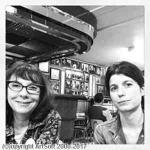Sophie Calle
Sophie Calle
Místo: Paris
Narozený: 1953
Životopis:
Sophie Calle is a French writer, photographer, installation artist, and conceptual artist. Calle's work is distinguished by its use of arbitrary sets of constraints, and evokes the French literary movement of the 1960s known as Oulipo. Her work frequently depicts human vulnerability, and examines identity and intimacy. She is recognized for her detective-like ability to follow strangers and investigate their private lives. Her photographic work often includes panels of text of her own writing.
Since 2005 Sophie Calle has taught as a professor of film and photography at European Graduate School in Saas-Fee, Switzerland. She has lectured at the University of California, San Diego in the Visual Arts Department. She has also taught at Mills College in Oakland, California.
Exhibitions of Calle's work took place at the Centre Georges Pompidou, Paris; Hermitage Museum, St. Petersburg, Russia; Musée d'Art et d'Histoire du Judaïsme, Paris; Paula Cooper Gallery, New York; Palais des Beaux-Arts, Brussels, Belgium; Videobrasil, SESC Pompeia, São Paulo, Brazil; Museum of Modern Art of Bahia, Salvador, Brazil; Whitechapel Gallery, London; and the De Pont Museum of Contemporary Art, Tilburg, Netherlands. She represented France at the Venice Biennale in 2007.
In 2017 she was shortlisted for the Deutsche Börse Photography Prize for her publication My All (Actes Sud, 2016).
In Suite Venitienne (1979), Calle followed a man she met at a party in Paris to Venice, where she disguised herself and followed him around the city, photographing him. Calle’s surveillance of the man, who she identifies only as Henri B., includes black and white photographs accompanied by text.
Calle's first artistic work was The Sleepers (Les Dormeurs), a project in which she invited passers-by to occupy her bed. Some were friends, or friends of friends, and some were strangers to her. She served them food and photographed them every hour.
In order to execute her project The Hotel (1981), she was hired as a chambermaid at a hotel in Venice where she was able to explore the writings and objects of the hotel guests. Insight into her process and its resulting aesthetic can be gained through her account of this project: "I spent one year to find the hotel, I spent three months going through the text and writing it, I spent three months going through the photographs, and I spent one day deciding it would be this size and this frame...it's the last thought in the process."
One of Calle's first projects to generate public controversy was Address Book (1983). The French daily newspaper Libération invited her to publish a series of 28 articles. Having recently found an address book on the street (which she photocopied and returned to its owner), she decided to call some of the telephone numbers in the book and speak with the people about its owner. To the transcripts of these conversations, Calle added photographs of the man's favorite activities, creating a portrait of a man she never met, by way of his acquaintances. The articles were published, but upon discovering them, the owner of the address book, a documentary filmmaker named Pierre Baudry, threatened to sue the artist for invasion of privacy. As Calle reports, the owner discovered a nude photograph of her, and demanded the newspaper publish it, in retaliation for what he perceived to be an unwelcome intrusion into his private life.
Another of Calle's noteworthy projects is titled The Blind (1986), for which she interviewed blind people, and asked them to define beauty. Their responses were accompanied by her photographic interpretation of their ideas of beauty, and portraits of the interviewees.
Calle has created elaborate display cases of birthday presents given to her throughout her life; this process was detailed by Grégoire Bouillier in his memoir The Mystery Guest: An Account (2006). According to Bouillier, the premise of his story was that "A woman who has left a man without saying why calls him years later and asks him to be the 'mystery guest' at a birthday party thrown by the artist Sophie Calle. And by the end of this fashionable—and utterly humiliating—party, the narrator figures out the secret of their breakup."
In 1996, Calle asked Israelis and Palestinians from Jerusalem to take her to public places that became part of their private sphere, exploring how one's personal story can create an intimacy with a place. Inspired by the eruv, the Jewish law that permits to turn a public space into a private area by surrounding it with wires, making it possible to carry objects during the Sabbath, the Erouv de Jérusalem is exposed at Paris's Musée d'Art et d'Histoire du Judaïsme.
The same year, Calle released a film titled No Sex Last Night which she created in collaboration with American photographer Gregory Shephard. The film documents their road trip across America, which ends in a wedding chapel in Las Vegas. Rather than following the genre conventions of a road trip or a romance, the film is designed to document the result of a man and woman who barely knew each other, embarking on an intimate journey together.
More...
Wikipedia link: Click Here




